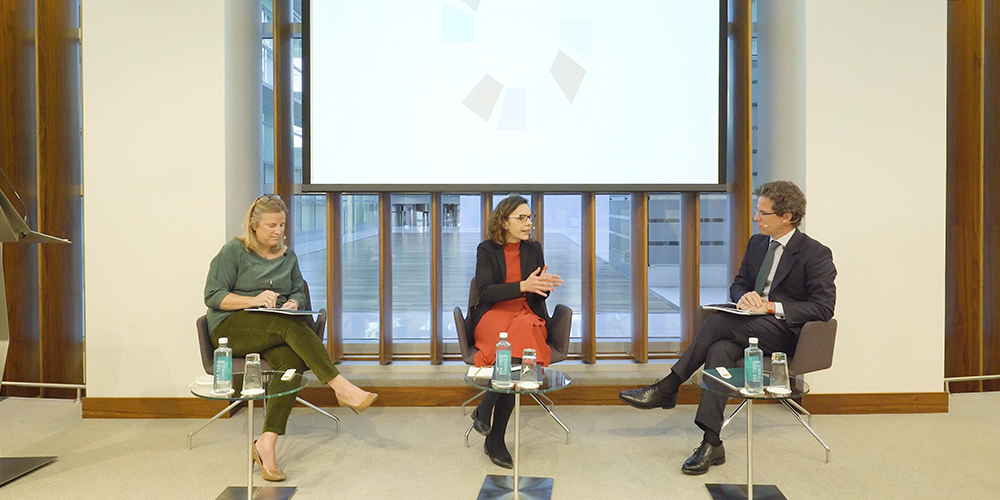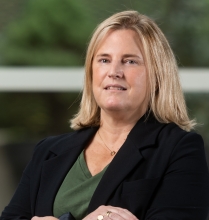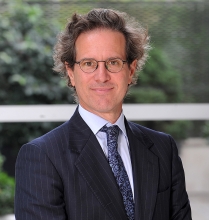The EIB spells out its commitment to green finance in ‘The Dialogues of Garrigues Sustainable’

This first ‘webinar’, dedicated to sustainable finance, addressed the requirements of the European Union and the EIB in matters of green bonds and loans
The commitment of the European Investment Bank (EIB) to sustainability is clear and growing. The institution has decided to increase its commitment to sustainable or “green” finance, currently at 25%, with a view to enabling it to reach 50% by 2025.
The foregoing statement was made by María Serrano, head of Energy Financing in Spain, of the EIB, during the first edition of The Dialogues of Garrigues Sostenible, a cycle of webinars in which the firm’s professionals invite one guest on each occasion, with whom to discuss key aspects related to ESG in the life of a company.
On this occasion, matters related to the requirements of the European Union and the EIB for green bonds and loans were discussed by the EIB expert with Sofía Lazcano, the partner in charge of G-advisory, and Gaspar Atienza, partner of the Corporate/Commercial Law Department of Garrigues.
As María Serrano pointed out, the EIB has been working on green loans for some time now and has years of experience on the matter. Its concern for sustainable finance had already begun in 2007, as did its effort to channel resources from other financiers with issues of green bonds. More recently there have been two fundamental milestones. The first was in 2019, when the energy lending policy was approved, setting the course to be taken with respect to the principles and commitments of the Paris Agreement and laying the foundation for energy financing that is very in line with those principles. The second took place last year with the approval of the Climate Bank roadmap, which provides a framework for bringing all economic industries, not only the energy industry, into line with the commitments already made in the energy lending policy. The goal is to channel resources from the private sector, mobilizing one billion investments in the critical decade (2021 - 2030), and also to increase the commitment to sustainable or green finance, currently at 25%, with a view to enabling it to reach 50% by 2025, as explained by the expert.
María Serrano thinks the EIB is on the right track. “The evaluation is, I believe, positive, but should not be conformist: much remains to be done and the main challenge will be to attract private finance”, she emphasized, adding that the investment needs, if the Paris targets are to be achieved, are very ambitious: “It is true that we have many available resources, but they are not going to be sufficient, and the challenge will be to get the private sector to join this effort in sustainable finance”.
Beyond the energy industry
The fact is that sustainability is no longer a choice: the ESG criteria have come to companies to stay. And this commitment is no longer limited to the energy industry alone, as pointed out by Gaspar Atienza during the encounter. In this connection, the EIB representative was clear: “In past years the energy industry claimed to be green, but now we have companies in all industries, from the fashion industry to the industrial sector, that want to signal their commitment to a sustainable production model. This is demanded by investors and consumers alike, and the world of finance will have to adapt”.
On the other hand, Sofía Lazcano recalled that in August 2021 the committee of experts of the European Commission’s Platform on Sustainable Finance published a draft report on preliminary recommendations for technical screening criteria for non-climate objectives. As explained by María Serrano, this is to be published in 2022, although she specified that the way in which this initiative is materialized in Community legislation will depend on the European political instances: “I think that much will be learned from the process, from what has happened until now with the two climate change objectives”. In any case, she emphasized the importance of “there being guidelines soon, above all to give investors legal certainty, which is what they need”.
COP26 news
María Serrano explained that the Climate Bank roadmap is a cross-cutting document with an impact on all of the bank’s financial and non-financial activities: “the most significant change made in 2021 was probably the commitment to align all of the activities we finance with the principles and commitments of the Paris Agreement”.
She also said that “it is a dynamic document that requires the ongoing incorporation of new initiatives”. And she announced, in preview, that news will be made in this connection at the COP26 in Glasgow in the coming weeks, with two very important announcements. First, she said, a framework will be presented, which ensures not only that the activities financed are in line with the targets and criteria of the Paris Agreement, but also that the clients financed are equally aligned: “This means that we will look at what their commitments are, beyond the asset we are financing, and ensure that all of the company’s activities, as well as its business model, are in line with these targets”, adding that, “of course mechanisms are envisaged to help those who are faced with a more challenging transition”. And the second announcement will be “an action plan to increase the financing aimed at adapting to climate change, which will clearly be one of the major challenges of the coming years. This is important for all countries, but especially for developing countries; it should be a global solution”, she insisted.
Expand the range of financial instruments
Gaspar Atienza pointed out the importance of providing legal certainty to investors. In this connection, he said that the document, which is very cross-cutting and innovative, emphasizes legal innovation and speaks of new financial instruments, with a view to broadening the horizon of the legal instruments that are to be used. In this connection, Maria Serrano said that this expansion of green financial products can already be seen: “We have a very wide range. In fact, one of the things we have seen at the EIB is that we need to expand the mechanisms, because it is not only a matter of labeling the type of loan we make, but also of ensuring that the financing goes where it is needed in the most efficient way possible, without forgetting that we have to catalyze private sector finance”.
She added that “it is a change in philosophy: we are going from using the Commission’s budgetary resources as a non-repayable grant to using them as a guarantee, which means that you are capable of multiplying their impact. On this basis we need to work on new instruments that enable us to reach places we are unable to reach at present, as the EIB, the European Commission and worldwide. To continue supplementing and expanding the range of financial instruments”.
Toward a better definition of ESG
Sofía Lazcano expressed the concern of some clients for a needed improvement in the definition and reporting of ESG in all instruments. In this connection, the EIB expert affirmed that this is being done: “for years, rating agencies have been including ESG criteria in their credit risk analyses, and the market is demanding it more and more. Not only do we want to know what the company’s EBITDA is, or whether it is fulfilling ratios, but we also want to have a complete photo of its business model incorporating ESG aspects”. In fact, she pointed out that there are a number of directives on the way which will oblige companies and financial institutions to increase this type of reporting. “At the EIB we are already doing this, but we want to take it one step further, to encourage our clients to make an effort in this connection. Moreover, furnishing this information to the market will be positive for the client itself”, she added.
‘Greenwashing’: the importance of standards
All methodology in favor of transparency, which is constantly increasing, will be essential in order to avoid greenwashing, as pointed out by Gaspar Atienza during the encounter. On this matter, María Serrano specified that “not only transparency, but also harmonization enables us to compare”. As she explained, “there were many instruments or agents on the market that were using the same name for different things. It is important for all of us to know what is behind these instruments, what assets are being financed. This will benefit everyone and there will come a time when it will attract more financing”.
Lastly, Sofía Lazcano encouraged the EIB expert to preview the targets on which the updating of environmental and social standards will be focused. “The standards are being reviewed; we were already putting strict criteria in practice with respect to what we required from all the investments we financed, in terms of environmental sustainability, impact mitigation, and now what we are doing is emphasizing the social part a little more”. She also said that there are a number of directives in progress in this area: “what we are doing is trying to get ahead of what may be coming”. She also explained that they often finance in geographies with very different legislations and, accordingly, it is essential to be able to base it on common criteria, on standards that permit the establishment of the minimums to be fulfilled.
In this connection, she specified that the social taxonomy, expected to be published in 2022, is being managed by the European Commission, and the lines being mapped out tend toward promoting governance, decent work, human rights … and this will make it possible to lay the groundwork for some minimums and for the harmonization and easier comparison of the investments financed, in order to attract new investors. “I believe that an investor who is concerned with the climate ambitions of the activities it finances is no less concerned with the fulfillment of human rights, and continuing to promote in this type of standards will be key”, concluded María Serrano.
Contacts



